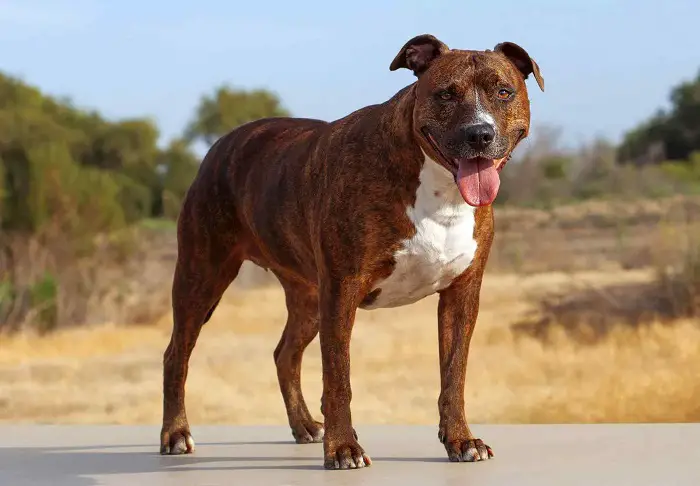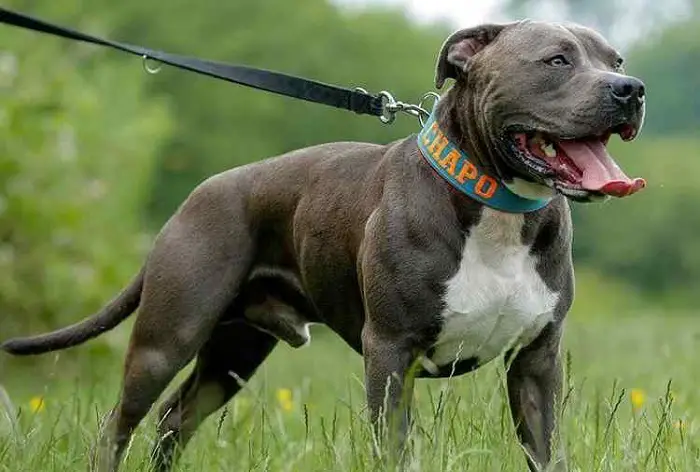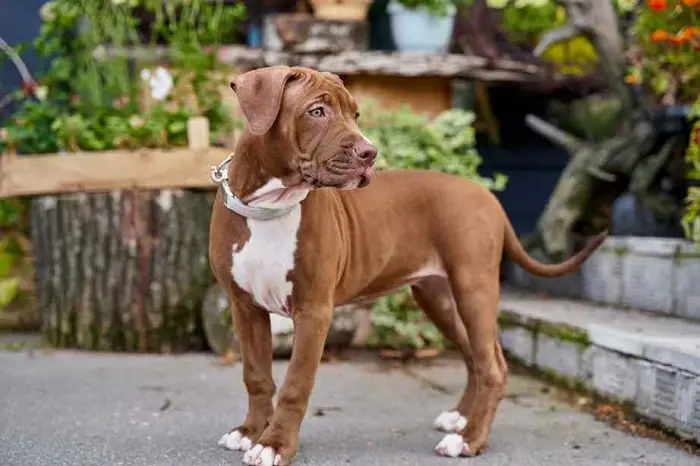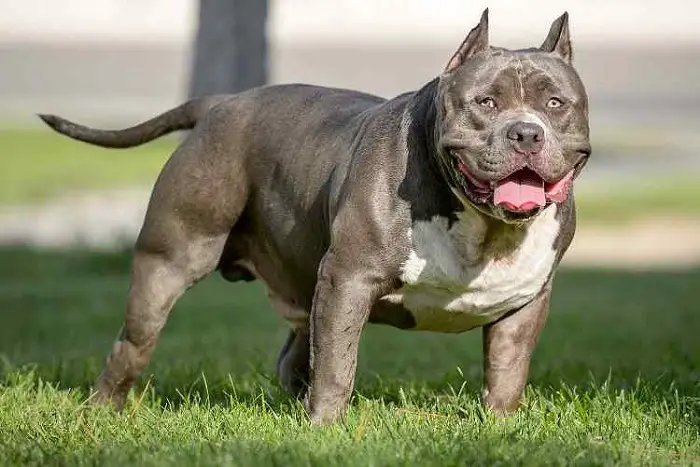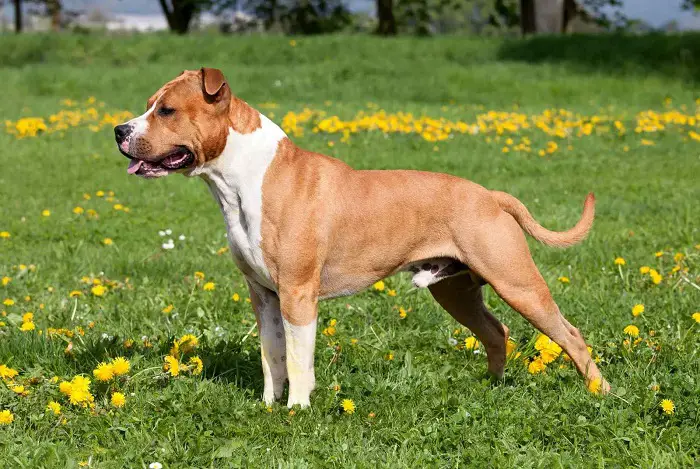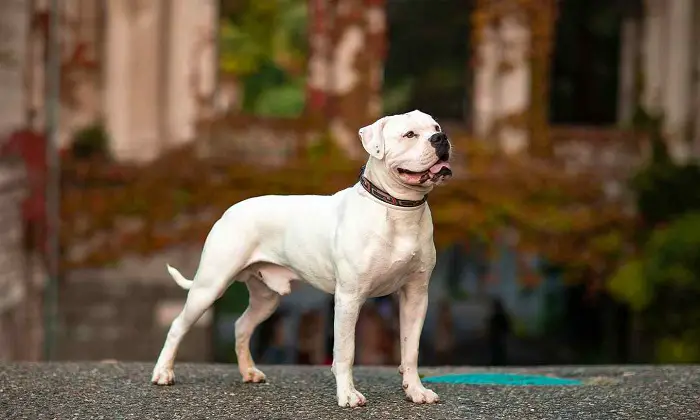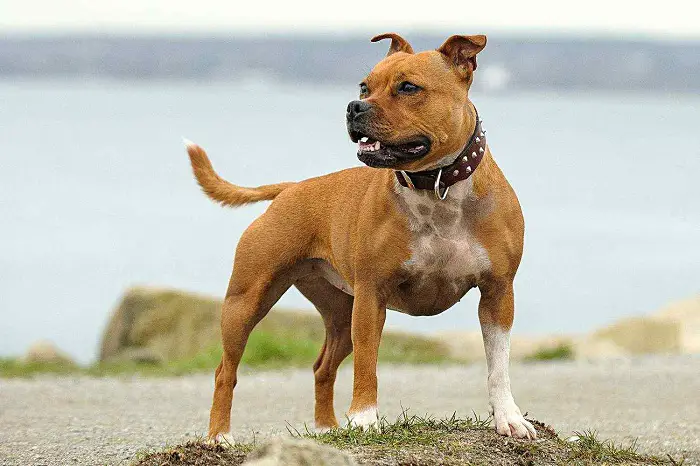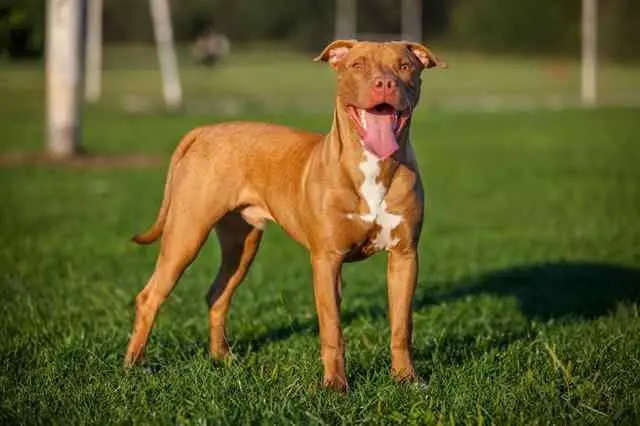Pitbulls are highly energetic and intelligent dogs. They were initially bred in the United States for various purposes, including hunting, herding, and as family companions. They have a reputation for their strength, agility, and loyalty. There are different types of pitbulls are present that you can choose from them for your house protection.
It’s important to note that the term “Pitbull” is often used as a broad label that encompasses several breeds and mixes, including the American Pit Bull Terrier, American Staffordshire Terrier, Staffordshire Bull Terrier, and sometimes even Bulldog breeds. These breeds share similar physical characteristics and often get grouped under the term “Pitbull.”
Pitbulls’ temperaments can vary like any dog breed, and individual dogs may have different personalities. They are generally known to be affectionate, protective, and loyal towards their families. However, responsible ownership, socialization, and training are crucial to ensure they are well-behaved and good members of society.
Physical Features of Pitbulls
Pitbulls have several distinctive physical features that set them apart from other breeds. Here are some common physical characteristics of Pitbull dogs:
- Size: Pitbulls are medium-sized dogs. The dogs usually stand between 17 to 20 inches (43 to 51 cm) tall at the shoulder and weigh between 30 to 60 pounds (14 to 27 kg).
- Muscular Build: Pitbulls have strong and muscular body. They have a well-defined chest, broad shoulders, and a powerful neck. Their overall physique reflects their athleticism and strength.
- Head: Pitbulls have a broad and powerful head with a well-defined jawline. The skull is generally round and slightly flattened, and the cheeks are muscular. The muzzle is relatively short and tapers towards the nose.
- Ears: Pitbulls often have cropped or natural ears. If left natural, their ears are medium-sized, set high on the head, and can be either rose-shaped (folded back) or semi-pricked (partially erect).
- Eyes: The eyes of Pitbulls are typically round and can come in various colors, including shades of brown, amber, or blue. The expression is often alert and intelligent.
- Coat: Pitbulls have short and smooth coat that lies close to their body. The coat is dense, stiff, and glossy in texture. The coloration can vary widely and includes solid, brindle, or patched patterns. Standard colors include fawn, black, blue, red, and white.
- Tail: The tail of a Pitbull is typically short and tapers to a point. It is set low and is carried in a relaxed manner. Some Pitbulls may have their tails docked, although this practice is becoming less common.
Are Pitbulls Dangerous?
Pitbulls have unfortunately been involved in some high-profile incidents and have gained a reputation for aggression. However, it’s crucial to recognize that breed alone is not an authentic predictor of a dog’s temperament or behavior. Numerous studies have shown that breed-specific legislation and breed-based stereotypes are ineffective at preventing dog bites and promoting public safety.
Responsible ownership, socialization, and positive training practices determine a dog’s behavior and temperament. When properly trained, socialized, and given appropriate care, Pitbulls can be friendly, loyal, and loving companions. It’s worth noting that Pitbulls often score well in temperament tests and are known for their affectionate and gentle nature towards people.
It’s essential for all dog owners, regardless of breed, to prioritize responsible pet ownership. This includes proper training, socialization, regular exercise, and a safe environment. Dogs that are neglected, mistreated, or improperly trained are more likely to exhibit aggressive behavior, regardless of their breed.
Ultimately, labeling an entire breed as inherently dangerous is unfair and inaccurate. Each dog should be evaluated individually, considering their behavior, training, and socialization. Responsible ownership and education are vital in promoting a safe and harmonious relationship between humans and dogs, regardless of breed.
Different Types of Pitbulls
When discussing the different types of Pitbulls, it’s important to note that the term “Pitbull” is often used as an umbrella term that encompasses several breeds and mixes with similar physical characteristics. Here are some of the common types or breeds that are often referred to as Pitbulls:
1. American Pitbull Terrier
The American Pit Bull Terrier (APBT) is known for its strength, athleticism, and loyalty. With its distinctive appearance and rich history, the APBT has garnered both admiration and controversy. This introduction will explore the origins, physical characteristics, temperament, and considerations of owning an American Pit Bull Terrier.
Originating in the United States, the APBT was initially bred for bull-baiting and later as an all-around working dog. Its ancestors were crossed with terriers and bulldogs, resulting in a breed with tenacity, strength, and agility. Over time, the APBT transitioned into a versatile companion, excelling in various roles such as farm work, hunting, and even as a family pet.
The APBT is a medium-sized dog with a muscular build. It has a broad, wedge-shaped head, a powerful jaw, and round, expressive eyes. The dog’s ears can be cropped or left natural, and its tail is typically short. The coat of an APBT is short and smooth, coming in various colors, including brindle, red, blue, and fawn.
Regarding temperament, the APBT is known for its loyalty and affection towards its family. It can be a gentle, friendly, and trustworthy companion with proper socialization, training, and care. APBTs are often described as people-oriented dogs, forming strong bonds with their owners and displaying an eagerness to please them.
While the American Pit Bull Terrier has a loving nature, responsible ownership is crucial. Providing them with appropriate training, exercise, and mental stimulation is essential to channel their energy and prevent behavioral issues. Socialization from a young age is also vital to help them interact positively with other animals and people.
2. Types of Pitbulls: American Bully
The American Bully is a breed of dog that originated in the United States. It was developed as a companion and family pet rather than for working purposes like its ancestors, such as the American Pit Bull Terrier. The breed was created by selectively breeding different bulldog and terrier-type dogs to achieve a specific look and temperament.
American Bullies are medium to large-sized dogs with a solid and muscular builds. They have a broad chest, well-defined muscles, and a powerful stance. The head is typically broad, and the muzzle is short and wide. The ears can be natural or cropped, and the eyes are generally round and expressive. The breed’s short, dense, glossy coat can come in various colors and patterns.
In terms of temperament, American Bullies are known for their loyalty, affection, and gentle nature. They are generally friendly and good-natured, both with their families and strangers. American Bullies are often described as eager to please, making them relatively easy to train. They are typically social with other dogs if adequately socialized from a young age.
It’s important to note that the American Bully breed has different size categories recognized by various kennel clubs, including Standard, Classic, Pocket, and XL. These categories vary in size, weight, and proportions but share similar breed characteristics and temperaments.
Due to their popularity, the American Bully breed has faced some controversies and misconceptions. Some people may confuse them with Pitbull-type dogs, but they are distinct breeds with different breed standards. As with any dog breed, responsible ownership, socialization, and training are essential to promoting a well-behaved and balanced American Bully.
3. American Staffordshire Terrier Dog
The American Staffordshire Terrier is known for its strength, intelligence, and loyalty. The dog is often referred to as the AmStaff for short. Here are some key characteristics and information about this breed:
- Appearance: American Staffordshire Terriers are medium-sized dogs with a muscular build. They have a broad heads, strong jaws, and a well-defined stop. Their eyes are round and dark, and their ears are set high on the head and can be either cropped or left natural. The breed has a short coat in various colors, including solid colors, party colors, or patched patterns.
- Temperament: AmStaffs are known for their loyalty and affection towards their family. They are generally friendly and good-natured, but they can be protective and wary of strangers. Proper socialization from an early age is crucial to ensure they develop into well-rounded dogs. They are intelligent and eager to please, making them trainable, but they can also be strong-willed.
- Exercise and Training: American Staffordshire Terriers are active dogs that need regular exercise to stimulate them physically and mentally. Daily walks, playtime, and interactive activities are essential for their well-being. They excel in dog sports, such as basic obedience, agility, and tracking. Consistent and positive training methods work best with this breed.
- Care and Grooming: AmStaff’s short coat is relatively easy to maintain. Regular brushing helps remove loose hair from the coat and keeps it healthy. They are average shedders and may require more frequent brushing during shedding seasons. Routine care includes dental hygiene, nail trimming, and regular check-ups with a veterinarian.
- Health: American Staffordshire Terriers can be prone to certain health conditions in dog breeds. These may include hip dysplasia, elbow dysplasia, heart disease, allergies, and skin issues. Responsible breeders perform health screenings on their breeding stock to reduce the risk of passing on hereditary conditions.
- Legal Considerations: It’s worth noting that American Staffordshire Terriers and several other breeds are sometimes subject to breed-specific legislation (BSL) or restrictions in certain jurisdictions due to concerns about aggression. These laws vary by location, so knowing any applicable regulations in your area is essential.
4. Types of Pitbulls: American Bulldog
The American Bulldog is a working dog breed known for its strength, athleticism, and protective nature. Here are some key characteristics and information about the American Bulldog:
- Appearance: American Bulldogs are medium to large-sized dogs with muscular and well-built bodies. They have a broad head, strong jaws, and a pronounced muzzle. Their ears can be naturally dropped, semi-prick, or cropped, and their eyes are typically almond-shaped and set wide apart. The breed has a short coat in various colors, including white, brindle, fawn, and combinations of these colors.
- Temperament: American Bulldogs are known for their loyalty and protective instincts towards their family. They are generally confident, courageous, and determined. With proper training and socialization from an early age, they can be friendly and sociable with people and other animals. However, they can be wary of strangers and may exhibit territorial behavior.
- Exercise and Training: American Bulldogs are active and energetic dogs that require regular exercise to prevent boredom and maintain their physical and mental well-being. They enjoy brisk walks, jogging, playtime, and interactive games. Early training and consistent positive reinforcement are essential to ensure they become well-behaved companions.
- Care and Grooming: The American Bulldog has a short coat that is relatively easy to maintain. Regular brushing helps keep their coat clean and free from loose hair. They are average shedders and may require more frequent brushing during shedding seasons. Routine care includes dental hygiene, nail trimming, and regular check-ups with a veterinarian.
- Health: American Bulldogs can be prone to specific health issues like many large breeds. These may include hip dysplasia, elbow dysplasia, cherry eye, allergies, and certain skin conditions. Responsible breeders perform health screenings on their breeding stock to reduce the risk of passing on hereditary conditions.
- Legal Considerations: Similar to other breeds, American Bulldogs, may be subject to breed-specific legislation or restrictions in certain areas due to concerns about aggression. Knowing any local laws or regulations that may apply to this breed in your region is essential.
5. Types of Pitbulls: Staffordshire Bull Terrier
The Staffordshire Bull Terrier, often referred to as the Staffie or Staffy, is a dog known for its strength, agility, and affectionate nature. Here are some key characteristics and information about the Staffordshire Bull Terrier:
- Appearance: Staffordshire Bull Terriers are medium-sized dogs with a muscular build. They have a broad head, short muzzle, and a strong jaw. Their eyes are usually dark and round, and their ears can be rose-shaped or half-pricked. The breed has a smooth and short coat in various colors, including red, fawn, white, black, blue, or any combination of these colors.
- Temperament: Staffies are known for their loyalty, intelligence, and love for their families. They are generally affectionate, friendly, and good with children, earning them the nickname “nanny dogs.” They are also known for their courage and determination. Proper socialization and training from an early age are essential to ensure they develop into well-behaved and balanced dogs.
- Exercise and Training: Staffordshire Bull Terriers are active dogs that require regular exercise and mental stimulation. Daily walks, playtime, and interactive activities are essential to keep them physically and mentally fit. They are intelligent and eager to please, making them trainable. Positive reinforcement methods work best with this breed.
- Care and Grooming: The Staffie’s short coat is relatively low-maintenance. Regular brushing helps remove loose hair and keeps their coat healthy. They are average shedders and may require more frequent brushing during shedding seasons. Routine care includes dental hygiene, nail trimming, and regular check-ups with a veterinarian.
- Health: Staffordshire Bull Terriers are generally healthy, but like any dog, they can be prone to specific health conditions. Some common health concerns include hip dysplasia, hereditary cataracts, skin allergies, and certain heart conditions. Responsible breeders perform health screenings on their breeding stock to minimize the risk of passing on hereditary conditions.
6. Types of Pitbulls: Rednose Pitbull Terrier
“Rednose Pitbull Terrier” is not a recognized breed by significant kennel clubs or breed organizations. However, “Rednose Pitbull” often describes American Pit Bull Terriers with reddish nose coloration.
Concluding Words on Types of Pitbulls
In conclusion, “Pitbull Terrier” often refers to several closely related breeds, including the American Pit Bull Terrier, Staffordshire Bull Terrier, and American Staffordshire Terrier. These breeds share strengths, athleticism, and loyalty but may have distinct characteristics and standards recognized by different kennel clubs.
It’s important to note that variations in coat color, such as blue or red nose, do not define separate breeds but rather cosmetic differences within them. Responsible ownership, proper socialization, and positive training are essential for raising well-behaved and balanced Pitbull Terriers.
As always, it’s crucial to research and understands any local regulations or breed-specific legislation that may apply to Pitbull Terriers in your area. Furthermore, consult reputable breeders or breed organizations for accurate information on specific types and variations within the Pitbull Terrier group.
